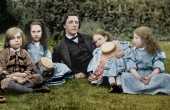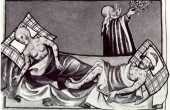TheCropsey
Contributing writer for The Artifice.
Junior Contributor III
- Articles
2 - Featured
1 - Comments
4
- Ext. Comments
3 - Processed
0 - Revisions
0
- Topics
2 - Topics Taken
0 - Notes
8
- Topics Proc.
6 - Topics Rev.
1
- Points
302 - Rank
X - Score
138
Latest Articles
Latest Topics
Monster Prom and Queer HorrorMonster Prom (2018) is the latest in a line of explicitly queer indie dating sims since the popularity of The Game Grumps’ Dream Daddy (2017). It’s tone is light, comedic, and playful, owing it’s mash-up of horror and sitcom tropes to predecessors like The Addams Family (1964), The Munsters (1964), Rocky Horror Picture Show (1975), a slew of campy monster beach party movies (e.g.: 1964’s The Horror of Party Beach), and even the recent popularity of the Monster High (2010) toy line and webseries. Monster Prom owes a lot to the "all-ghoul school trope," but it is also unapologetically queer; the game’s Kickstarter page includes a blurb on the subject: "Don’t worry if you want to romance a certain love interest as a certain character! In Monster Prom characters don’t like boys or girls… they like people." This is a kind counterpart to the long tradition of queer-coded monsters and villains in horror cinema, a topic extensively covered in Harry Benshoff in his book Monsters in The Closet: Homosexuality and The Horror Film (1997). Monstrous and villainous queer subtext can be observed famously in classic monster movies like Frankenstein (1931)– which prominently features two men privately collaborating to create new life (and was, directed by a gay man, James Whale)– Dracula’s Daughter (1936)– which features a butch female vampire and her effeminate male manservant– and later films like Nightmare on Elm Street II: Freddy’s Revenge (1985) and Reanimator (1985). The purpose of this article is to trace the trickle: how did our media shift from implicitly queer monsters as villains to explicitly queer monsters as love interests? Also consider the quasi-ironic queer nerd slogan: "The Babadook is a gay icon" and even the non-normative love story that takes place in The Shape of Water (2017).
|
Radical Acceptance in PodcastsExplore the ways in which interpersonal conflict is presented, explored, and addressed in popular podcasts like Judge John Hodgman (Maximum Fun) and Conversations with People Who Hate Me (Nightvale Presents). These are shows which address emotional, yet relatively minor disputes in a public, drama-free environment. What is it about podcasts like these that breeds frank honesty and polite empathy at the same time? |
Latest Comments
| The Lewis Carroll Problem | |
It’s good to see discussions of represented disabilities include both physical and cognitive ailments. They’re so often polarized and separated in criticism– and don’t get me wrong, they are fundamentally different– but the tropes they fall into are more like a vehn diagram than two separate lists. | Disability in Comics: The Misconstrued Representation |
This is a great article. On a personal note, I read it with a cat on either side of me, and my main interests are scholarship and the arts. It’s a pretty fun stereotype to live up to imo; cats are compatible with the sedentary academic lifestyle, since they’re willing to just sort of chill with you adjacently and let you do your thing. Reminds me of the Medieval Irish poem “Pangur Bán,” in which the speaker, who is some type of scholar, compares the practice of logic to his pet cat’s skill at hunting mice. I also feel like the duality of feline representation in art and history (their association with holiness/skill versus devilry/sloth, like you mentioned) relates pretty easily to small cats’ status as both hunters and prey in their natural habitats. It’s part of why their behavior seems so bizarre to us; they’re at the center of the food chain, so they have to be good at both hunting and hiding. | The Truth About Cats and Artists |
I adore this show. Although, I disagree that “‘The Gang’s’ treatment of Rickety Cricket [is not] so aggressive or malicious as to be […] socially unacceptable,” as The Gang’s behavior towards Cricket, each other, and everyone they come into contact will pushes depravity to its logical extreme, in my opinion. I always thought the nugget of comedy at the show’s center was 1) absurdism and exaggeration (parodying the acceptable foibles of classic sitcom characters from shows like The Honeymooners or Taxi) and 2) radical acceptance of everyone’s capacity to be terrible people. The Gang are almost analogous to cardinal sins personified in Early Modern morality plays: we can recognize their “bad” traits in ourselves and identify which gang member (e.g.: which variety of human weakness) we find in ourselves the most. We can then use that information to look inward, see that we ourselves aren’t so bad after all and understand the potential fallout of letting those proclivities get the best of us. I think that’s where the quazi-social acceptability of Sunny really comes in: we can confront ourselves– and ne’er-do-wells that range between the store brand hypocrites we meet every day to famous reprobates like Ted Bundy and Bernie Madoff– in a safe manner through The Gang. | "It's Always Sunny" and Why We Laugh at Bad People |


Woah, that would be an honor! I know I’m really late with this response (I’ve been inactive on here for years), but I’m on the adjunct teaching circuit now, so even the possibility of having my work discussed in a classroom means a lot to me. Do you remember if it got discussed at all?